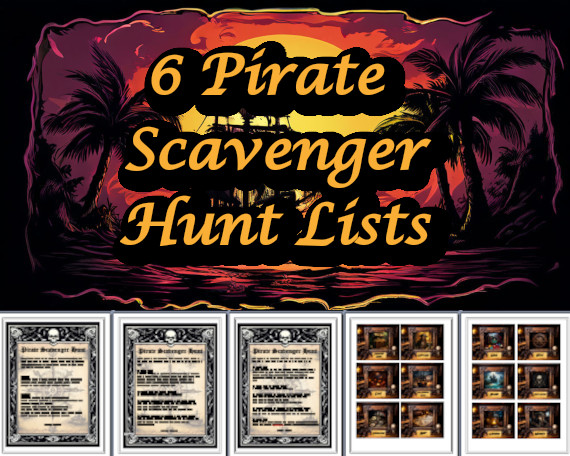
Basic Treasure Hunt
There
are many possible places to begin when creating a treasure hunt. Although
it largely depends on the type of treasure hunt you're looking to plan,
there are some basic questions that are good to answer early on in the
planning to help guide all future ideas and decisions.
* How many teams will be participating? You'll need to know how
many groups/teams will be participating so that you can provide enough
materials for everyone to successfully navigate the treasure hunt. If
one group of four girls will go on the hunt together as one group, then
you'll be dealing with one team, etc. Knowing how many participants you'll
be dealing with will also help choose locations that can facilitate those
numbers.
 |
6 Pirate Themed Scavenger Hunt Lists - Download them all now! With six different lists to choose from, you won't have any trouble finding the perfect activity you'd like to plan. There's even a for prereaders (with images only.) High quality images are also included that can be printed and hidden so that your scavenger hunt can be set up just about anywhere. Photo hunt options, bonus points and even a couple puzzles thrown in. You'll find the list that's just right for you! CLICK HERE TO DOWNLOAD THEM! |
* How long would you like the treasure hunt to last? This is a
good one to get a grasp of early on because many of the key decisions
that you make after this will affect the answer. The possible variables
that can affect the amount of time it takes to complete the hunt includes:
Distance between the locations, mode of transportation (vehicles, walking,
etc.), age of participants (younger tend to run, older tend to take a
more leisurely pace), the number of locations (the more locations on the
hunt, the longer it takes to complete the hunt), the complexity of the
puzzles (the longer they take to solve, the longer the hunt will take
overall) and the size of the tasks you're having them complete (if you
are incorporating tasks and activities.)
Now, we know that a basic treasure hunt involves going from location to
location in a fun way until a final destination is arrived at where any
number of things could be waiting for them. There are different ways to
leave a clue in a basic format. An obviously traditional way is to leaving
the good old fashioned rhyming clue. However consider these other options
before you settle for the obvious:
* Use images or photos. There are two ways to use them. The first is using
an image of an object as a clue. For example, perhaps it's a picture of
a stove. The treasure hunter would then get the idea that perhaps the
next clue is in or around the stove (if the hunt is inside the house.)
The other is to take an actual photo of the next location. This could
get interesting very quickly! Perhaps the pictures that you take are obscure
in camera angle or in subject matter. Your treasure hunters will have
fun looking at the pictures and trying to guess what it is a picture of!
* Written clues (other than the rhyming kind.) There are an infinite number
of ways to leave a clue in written form to lead to a location - you are
limited only by your imagination. However, here are some fun ideas to
consider:
* Use a book that everyone has a copy of (the EXACT book). Reference page
numbers and paragraphs in the book to reveal your clues. This works especially
well with the Bible. (For an example of how to use this with the Bible,
click HERE.)
* Leave a phone number for them to call. Ask a friend to stand by at a
certain time with their phone handy. Give them specific instructions on
what to say when the treasure hunter(s) call to get the clue. You can
do this as many times as you have friends with different phone numbers!
* Encode the clue in any number of ways. We caution with this one, though.
This type of activity can get tedious quickly. Don't use a lot of words
in the cipher if you choose to go this route.
When it comes to your basic treasure hunt, choosing your locations is
perhaps the most important decision you'll make. If you're ONLY going
to have them go from location to location, make sure that you entertain
them with the locations. Avoid the obvious and go for the interesting.
You can also inject a lot of creativity into the way the clue is left
for the treasure hunter when she arrives at the location. Remember, the
goal is to make it interesting above all. Here are some fun ideas to consider:
* Put the clues in Microsoft WORD documents that are password protected
(look under OPTIONS when you save). You can work the password into the
puzzle as well (i.e. perhaps the password is provided, but it is encoded,
etc.)
* Roll up the clues and tie with ribbon
* Use small bags of candy (i.e. M & M's) and put the clue inside (rolling
it up tightly and inserting it.) Just be sure that the slit you snip in
the bag is smaller than the individual candies inside!
* Use special paper (see our antiqued paper selection HERE.)
* Tie the clue to a string and dangle the string out an open window. The
treasure hunter will need to get to the window and pull in the string
to get to the clue.
* Leave the clue on a computer screen and let the screen saver take over.
Once the treasure hunter taps the keyboard, the clue will be waiting for
them!
* For some messy fun, put the clue inside a sealed plastic baggie and
put the baggie inside a food container (i.e. at the bottom of a filled
yogurt cup, inside a glass of soda, etc.)
There are so many other fun things to incorporate into your basic treasure
hunt, too many to ever detail them all here. From allowing them to dig
clues up from the dirt, to diving in a pool to leaving small gifts at
the locations for the participant to collect along the way - explore them
all. Always remember, you want your treasure hunter(s) to be engaged and
interested…not perplexed or stumped. Interesting ideas will always
be a better choice to difficult puzzles, even for the puzzle lover.
Looking for something more that what was described here? Then you're probably
ready to take it to the next level - Adventure Treasure Hunts - click
HERE
to read more…